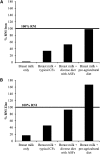The challenge of meeting nutrient needs of infants and young children during the period of complementary feeding: an evolutionary perspective
- PMID: 24132575
- PMCID: PMC3827643
- DOI: 10.3945/jn.113.182527
The challenge of meeting nutrient needs of infants and young children during the period of complementary feeding: an evolutionary perspective
Abstract
Breast-fed infants and young children need complementary foods with a very high nutrient density (particularly for iron and zinc), especially at ages 6-12 mo. However, in low-income countries, their diet is usually dominated by cereal-based porridges with low nutrient density and poor mineral bioavailability. Complementary feeding diets typically fall short in iron and zinc and sometimes in other nutrients. These gaps in nutritional adequacy of infant diets have likely been a characteristic of human diets since the agricultural revolution ~10,000 y ago. Estimates of nutrient intakes before then, based on hypothetical diets of preagricultural humans, suggest that infants had much higher intakes of key nutrients than is true today and would have been able to meet their nutrient needs from the combination of breast milk and premasticated foods provided by their mothers. Strategies for achieving adequate nutrition for infants and young children in modern times must address the challenge of meeting nutrient needs from largely cereal-based diets.
Conflict of interest statement
Author disclosures: K. G. Dewey, no conflicts of interest.
Figures

References
-
- Dewey KG, Brown KH. Update on technical issues concerning complementary feeding of young children in developing countries and implications for intervention programs. Food Nutr Bull. 2003;24:5–28. - PubMed
-
- WHO. Complementary feeding of young children in developing countries: a review of current scientific knowledge. Geneva: World Health Organization; 1998.
-
- thousanddays.org [homepage on the Internet] [cited 2012 Oct 29]. Available from: http://www.thousanddays.org/.
-
- Dewey KG, Huffman SL. Maternal, infant, and young child nutrition: combining efforts to maximize impacts on child growth and micronutrient status. Food Nutr Bull. 2009;30:S187–9. - PubMed
-
- Victora CG, de Onis M, Hallal PC, Blossner M, Shrimpton R. Worldwide timing of growth faltering: revisiting implications for interventions. Pediatrics. 2010;125:e473–80. - PubMed

